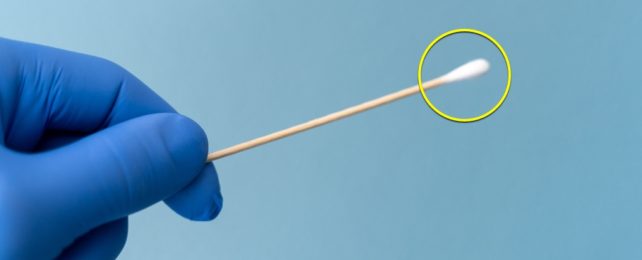As the coronavirus pandemic has shown, it's not just known viruses we've got to worry about: scientists and doctors also need to be looking out for new, emerging variants that can evade current treatments and catch us unawares.
There are a number of ways we can suss out new viruses that might be a threat to human health. Monitoring illness in animals, for example, could give us a heads-up on viruses that might yet jump species.
Unfortunately there's a huge amount of ground to cover in the search, and not all animal pathogens are destined to infect humans.
A nasal swab test developed by researchers from the Yale University could rapidly alert experts to the presence of an unknown menace starting to emerge in a population, without needing to detect the virus directly.
Based on initial tests, it could be a quick and effective way of spotting hidden viruses that would otherwise get missed.
"Although screening animal or pooled human samples might identify unrecognized viruses, this approach does not specifically identify viruses capable of causing human disease," write the researchers in their published paper.
"Monitoring for unexplained outbreaks targets human pathogens but might find emerging viruses too late – i.e. after an epidemic has already begun."
The new study builds on previous research from some of the same team, which looked at an anomaly in results from nasal swabs that were already taken from patients with suspected respiratory infections.
Typical tests on nasal swabs intend to detect around 10 to 15 known viruses, but the earlier research showed that in some cases there was still evidence that the body was fighting infection, even when no virus was recognized. Specifically, high levels of an antiviral protein made by the nasal lining called CXCL10 could be detected.
In the new study, a thorough process of genetic sequencing was deployed to old nasal swab samples where CXCL10 had been found in abundance, turning up the presence of an rare influenza virus called influenza C.
Through the same process, the team found four cases of COVID-19 that had gone undetected at the time the samples were taken.
A typical hospital might get through hundreds of nasal swabs every week that show no sign of a recognized virus, but the presence of CXCL10 would indicate that the body had sensed that a virus was present – meaning the swab was worthy of a closer look.
In other words, even if we're missing viruses in samples, the reaction of the human body can alert us to new variants that aren't on record. Many more emerging viruses could be spotted and looked at in this way, the researchers suggest.
That suggests that scanning for CXCL10 could narrow down the samples that should be tested for unknown viruses. It wouldn't lead to a hit in every case, but it would improve efficiency in the search for new outbreaks.
"Since this approach relies on immune recognition of features common to many viruses, it requires no previous knowledge of the pathogen," write the researchers.
Future research could take a closer look at other proteins that might have the same association, and at how nasal bacteria could also point towards the presence of a virus – another link that the results from the new study hint at.
"Finding a dangerous new virus is like searching for a needle in a haystack," says immunobiologist Ellen Foxman, from the Yale School of Medicine in Connecticut. "We found a way to significantly reduce the size of the haystack."
The research has been published in The Lancet Microbe.
